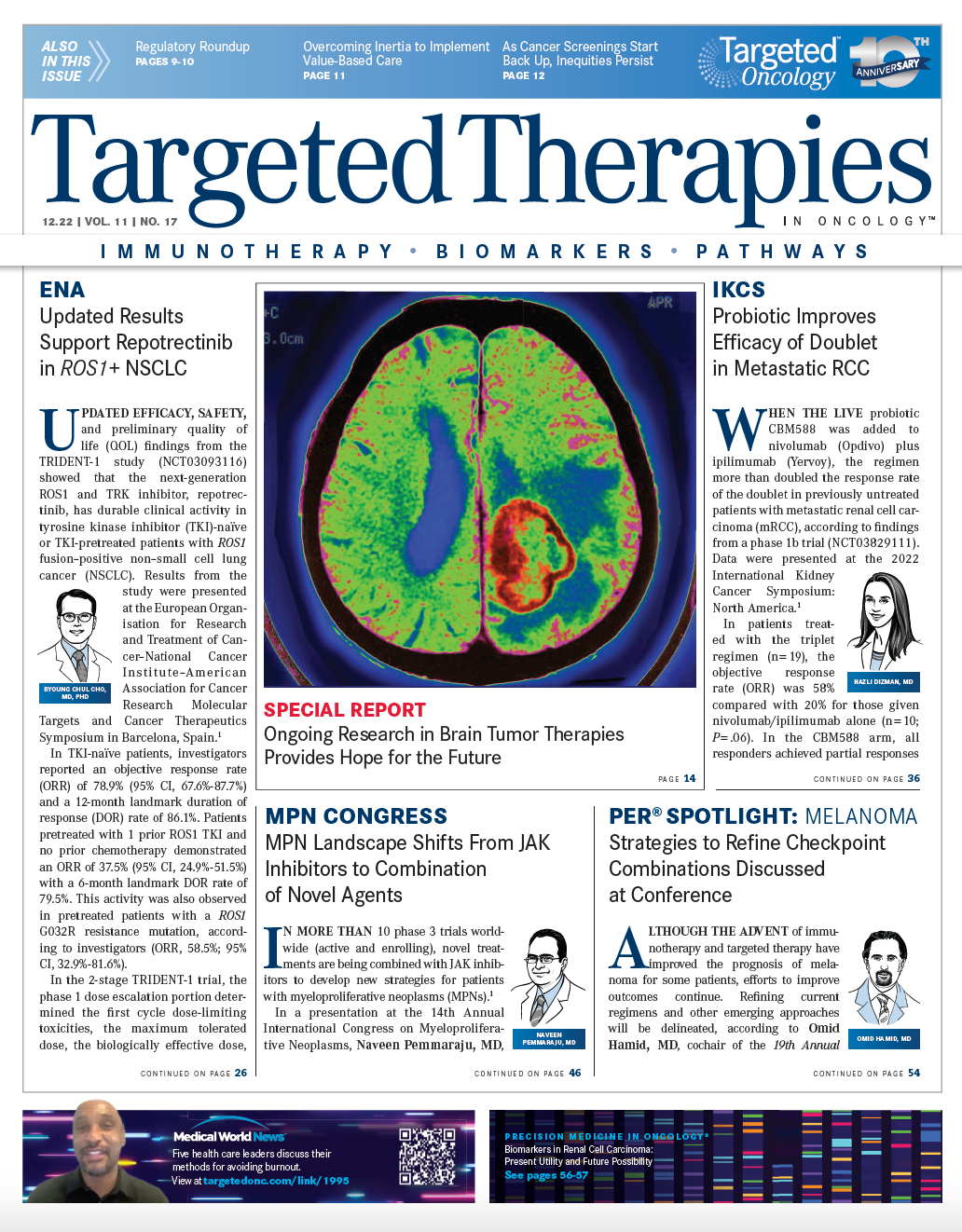Updates Results Support Repotrectinib in ROS1+ NSCLC
Updated findings from the TRIDENT-1 suggest that repotrectinib could represent a potential new treatment option for patients with ROS1- positive advanced non–small cell lung cancer, according to Byoung Chul Cho, MD, PhD.
Byoung Chul Cho, MD, PhD

Updated efficacy, safety, and preliminary quality of life (QOL) findings from the TRIDENT-1 study (NCT03093116) showed that the next-generation ROS1 and TRK inhibitor, repotrectinib, has durable clinical activity in tyrosine kinase inhibitor (TKI)-naïve or TKI-pretreated patients with ROS1 fusion–positive non–small cell lung cancer (NSCLC). Results from the study were presented at the European Organisation for Research and Treatment of Cancer– National Cancer Institute–American Association for Cancer Research Molecular Targets and Cancer Therapeutics Symposium in Barcelona, Spain.
In TKI-naïve patients, investigators reported an objective response rate (ORR) of 78.9% (95% CI, 67.6-87.7) and a 12-month landmark duration of response (DOR) of 86.1%. Patients pretreated with 1 prior ROS1 TKI and no prior chemotherapy demonstrated an ORR of 37.5% (95% CI, 24.9-51.5) with a 6-month landmark DOR of 79.5%. This activity was also observed in pretreated patients with ROS1 G032R resistance mutation, according to investigators (ORR, 58.5%; 95% CI, 32.9-81.6).
In the 2-phase TRIDENT-1 trial, the phase 1 dose escalation portion determined the first cycle dose-limiting toxicities, the maximum tolerated dose, the biologically effective dose, and recommended phase 2 dose of repotrectinib. Eligible patients had locally advanced or metastatic solid tumors harboring ROS1 or NTRK1-3 gene fusions. Patients received 160 mg of repotrectinib once daily for 14 days, then 160 mg of repotrectinib twice daily.
Four expansion cohorts were identified: expansion 1 included ROS1 TKI-naïve patients (n=110), expansion 2 included patients with 1 prior ROS1 TKI and 1 prior platinum-based chemotherapy (n=60), expansion 3 included patients who had 2 prior ROS1 TKIs and no prior chemotherapy (n=40), and expansion 4 included patients who received 1 prior ROS1 TKI and no prior chemotherapy (n=60). Findings from the presentation focused on expansion cohorts 1 and 4, according to Byoung Chul Cho, MD, PhD, of the Yonsei Cancer Center in Seoul, South Korea.
The primary end point was ORR using RECIST v1.1 criteria, and secondary end points included DOR, clinical benefit rate (CBR), time to response, and ORR in TKI-pretreated patients harboring ROS1 G2032R. The primary efficacy population includes patients pooled from phases 1 and 2 who began repotrectinib treatment at least 8 months prior to the data cutoff date of June 20, 2022.
Reviewing baseline characteristics across all 4 cohorts, median age was in the 50s and most patients were women who were never smokers. Regarding prior TKI use, in cohort 4 (n=56), 82% received crizotinib (Xalkori) and 16% used entrectinib (Rozlytrek). In cohort 2 (n = 26), 81% received crizotinib and 15% received entrectinib. In cohort 3, 100% received crizotinib, 71% received lorlatinib (Lorbrena), and 17% received entrectinib.
In TKI-naïve patients with ROS1-positive advanced NSCLC, after a median follow-up of 18.1 months, ORR was 78.9% (95% CI, 67.6%-87.7%) with 4 (5.6%) complete responses (CRs) and 52 (73.2%) partial responses (PRs). In this cohort, the CBR was 94.4% (95% CI, 86.2%-98.4%).
For all treated patients (n=71), the median DOR was 13.3 months (range, 0.80-60.6+). Sixty-three percent of patients remained on treatment. Among all patients with a CR (n=56), the median DOR was 15.5 months (range, 3.1-60.6+) with 75% of patients remaining on treatment. “After a median follow-up of 18.1 months, DOR and PFS [progression-free survival] data are still immature,” Cho said. “The DOR and PFS at 12 months were 86% and 79%, respectively.”
In the cohort of patients pretreated with 1 TKI and no prior chemotherapy, after a median follow-up of 15.5 months, the ORR was 37.5% (95% CI, 24.9%-51.5%). Three patients (5.4%) had a CR and 18 (32.1%) had a PR. The CBR in this cohort was 89.1% (95% CI, 69.6%-91.1%).
For all treated patients (n=56), median DOR was 8.3 months (range, 0.50-24.8+) with 34% of patients remaining on treatment. Of all patients with a CR (n=21), median duration of treatment was 11.2 months (range, 5.6-21.3) with 57% remaining on treatment. In patients pretreated with 1 TKI and no prior chemotherapy, after a median follow-up of 15.5 months, the DOR was 79.5% and PFS was 67.4%.
In cohort 2, after a median follow-up of 21.3 months, the ORR for change in tumor burden was 42.3% (95% CI, 23.4-63.1) with 1 CR and 10 PRs. Nearly 64% of patients had a DOR of 6 months or more (95% CI, 35.2%-92.1%), and 38.9% (95% CI, 19.4%-58.4%) had a PFS of 6 months or more.
In cohort 3, after a median follow-up of 14.1 months, the ORR for change in tumor burden was 27.8% (95% CI, 9.7%-53.5%) with 1 CR and 4 PRs. The DOR after 6 months or more was 60% (95% CI, 17.1-100.0%), and PFS after 6 months or more was 22.2% (95% CI, 3.0%-41.4%).
In patients with a ROS1 G2032R resistance mutation (n=17), the ORR was 58.8% (95% CI, 32.9%-81.6%) with 1 CR and 9 PRs. CBR was 70.6% (95% CI, 44.0%-89.7%), and DOR of 6 months or more was 70% (95% CI, 41.6%-98.4%).
In the pooled cohorts of patients with ROS1-positive advanced NSCLC, 20 patients were evaluable. In the ROS1 TKI-naïve cohort, the intracranial ORR was 87.5% (95% CI, 47.3%-99.7%), and in the cohort with no prior chemotherapy pretreated with 1 TKI, the intracranial ORR was 41.7% (95% CI, 15.2%-72.3%).
Regarding safety, the most common treatment-emergent adverse event (TEAE) was low-grade dizziness (61.3%), which was grade 1 in 73.2% of patients. Overall, 19.6% of patients reported ataxia, with 20 patients (4.5%) reporting ataxia in the absence of dizziness. Cho added that 45% of patients had TEAEs leading to drug interruption, 34% had TEAEs leading to dose reductions, and 9.7% had TEAEs leading to drug discontinuation.
Global health status and QOL were also assessed. In both TKI-naïve and TKI-pretreated patients, mean QOL did not deteriorate from baseline during treatment. Cho said median time to first improvement was observed at 3.71 months for global health status and 4.69 months for QOL. “These updated findings suggest that repotrectinib could represent a potential new treatment option for patients with ROS1-positive advanced NSCLC,” Cho concluded.
REFERENCES:
Cho BC, Lin JJ, Camidge DR, et al. Pivotal topline data from the phase 1/2 TRIDENT-1 trial of repotrectinib in patients with ROS1+ advanced non-small cell lung cancer (NSCLC). Presented at: EORTC-NCI-AACR Molecular Targets and Cancer Therapeutics Symposium; http://bit.ly/3t92SyE

Survivorship Care Promotes Evidence-Based Approaches for Quality of Life and Beyond
March 21st 2025Frank J. Penedo, PhD, explains the challenges of survivorship care for patients with cancer and how he implements programs to support patients’ emotional, physical, and practical needs.
Read More